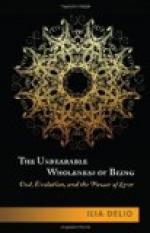If Christiane represented sensuality, unrelieved by any other feeling, Frau von Stein represented the most important object of Goethe’s craving for spiritual love. These two liaisons were to some extent contemporaneous; the Roman Elegies and the famous letters to Charlotte von Stein were written at the same period. When she reproached him with his love-affair with Christiane, he replied with consistent dualism: “And what sort of an affair is it? Whose interests are suffering by it?” Frau von Stein, his senior by seven years, was thirty-four years old, and mother of seven children when Goethe first met her. According to Schiller she “can never have been beautiful,” and in a letter to Koerner the latter says: “They say that their relationship (Goethe’s and Charlotte von Stein’s) is absolutely pure and irreproachable.” It was a great mistake ever to regard this relationship as anything but a purely spiritual one; Goethe never felt any passion for Charlotte; he called her “his sister,” the “guide of his soul”; he told her of his little love-affairs and was never jealous of her husband. The following are a few typical passages culled from his letters, arranged chronologically: “My only love whom I can love without torment!” Then, quite in the spirit of the dolce stil nuovo: “Your soul, in which thousands believe in order to win happiness,” “The purest, truest and most beautiful relationship which (with the exception of my sister) ever existed between me and any woman.” “The relationship between us is so strange and sacred, that I strongly felt, on that occasion, that it cannot be expressed in words, that men cannot realise it.” The following passage written by Goethe when he was thirty, might have been written by Guinicelli or by Dante: “You appeared to me like the Madonna ascending into heaven; in vain did the abandoned mourner stretch out his arms, in vain did his tearful glance plead for a last return—she was absorbed in the splendour surrounding her, longing only for the crown hovering above her head.” “I long to be purified in triple fire so as to be worthy of you.” He addresses a prayer to her and says: “On my knees I implore you to complete your work and make a good man of me.” “While writing Tasso, I worshipped you.” Charlotte knew intuitively what he desired of her, and remained silent and passive like the Madonna. Not a single sensual, or even passionate word, replied to all these utterances.
In the course of time the relationship between the lovers became one of equality; the note of adoration disappeared, and the keynote of his letters became friendship and familiarity. “Farewell, sweet friend and beloved, whose love alone makes me happy.” In another letter he said that all the world held no further prize for him, since he had found everything in her. And just as spiritual love approached more and more the mean of a familiar friendship, so was his sexuality concentrated on a single woman, on Christiane, in this connection, too, seeking a mean. But it is an important point that the fundamental dualistic feeling remained unchanged. There was no woman in Goethe’s life in regard to whom he arrived at, or even aspired to, the blending of both emotions in a higher intuition.




